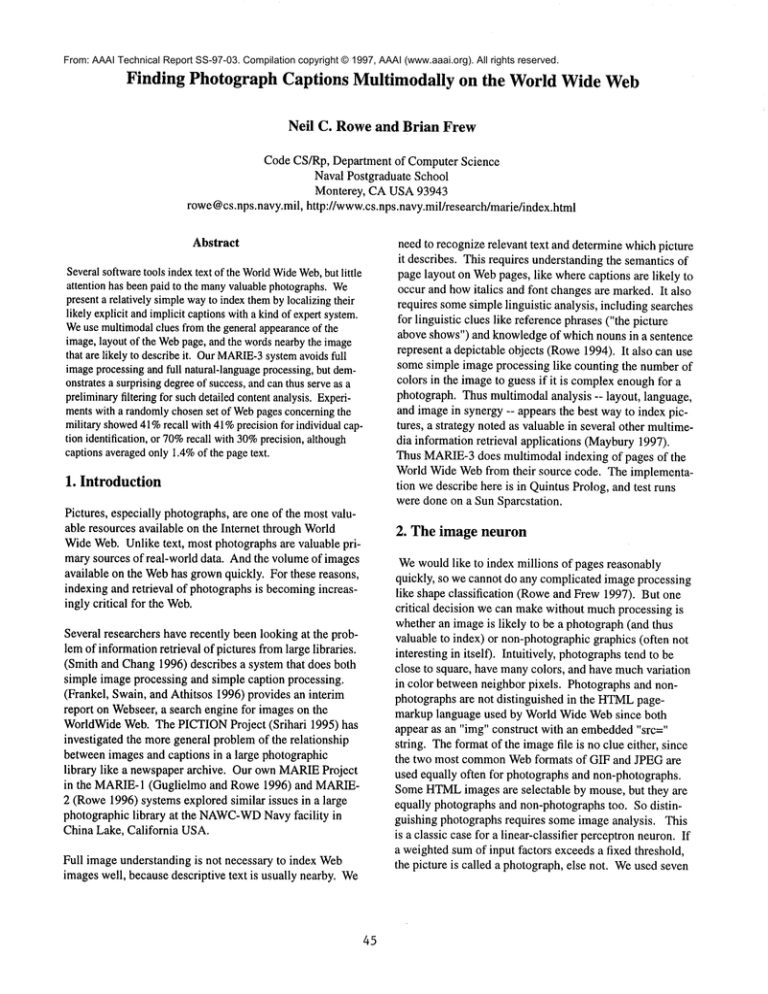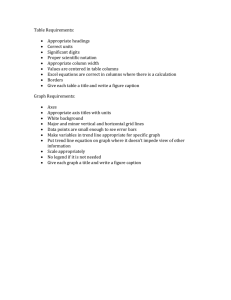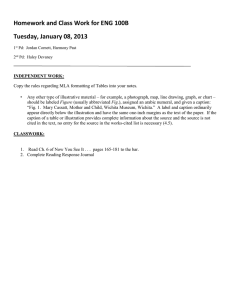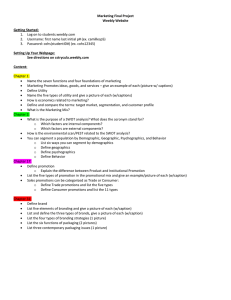Finding Photograph Captions Multimodally on the ...
advertisement

From: AAAI Technical Report SS-97-03. Compilation copyright © 1997, AAAI (www.aaai.org). All rights reserved. Finding Photograph Captions Multimodally on the World Wide Web Neil C. Rowe and Brian Frew Code CS/Rp, Department of Computer Science Naval Postgraduate School Monterey, CAUSA93943 rowe@cs.nps.navy.mil,http://www.cs.nps.navy.mil/research/marie/index.html Abstract Severalsoftwaretools indextext of the WorldWideWeb,but little attention has beenpaid to the manyvaluablephotographs.We presenta relatively simplewayto indexthemby localizingtheir likely explicit andimplicitcaptionswitha kindof expertsystem. Weuse multimodalclues fromthe general appearanceof the image,layout of the Webpage, and the wordsnearbythe image that are likely to describeit. OurMARIE-3 systemavoidsfull imageprocessingand full natural-languageprocessing,but demonstratesa surprisingdegreeof success,and canthus serveas a preliminaryfiltering for suchdetailed contentanalysis.Experimentswith a randomlychosenset of Webpagesconcerningthe military showed 41%recall with41%precision for individual caption identification, or 70%recall with30%precision,although captionsaveragedonly1.4%of the pagetext. 1. Introduction Pictures, especially photographs,are one of the most valuable resources available on the Internet through World WideWeb.Unlike text, most photographs are valuable primary sources of real-world data. Andthe volumeof images available on the Webhas grownquickly. For these reasons, indexing and retrieval of photographsis becomingincreasingly critical for the Web. Several researchers have recently been looking at the problemof informationretrieval of pictures fromlarge libraries. (Smith and Chang1996) describes a system that does both simple image processing and simple caption processing. (Frankel, Swain, and Athitsos 1996) provides an interim report on Webseer,a search engine for images on the WorldWideWeb. The PICTIONProject (Srihari 1995) has investigated the moregeneral problemof the relationship betweenimages and captions in a large photographic library like a newspaperarchive. Our own MARIE Project in the MARIE-1(Guglielmo and Rowe1996) and MARIE2 (Rowe1996) systems explored similar issues in a large photographic library at the NAWC-WD Navyfacility in China Lake, California USA. Full image understanding is not necessary to index Web imageswell, because descriptive text is usually nearby. We 45 need to recognize relevant text and determinewhich picture it describes. This requires understandingthe semantics of page layout on Webpages, like wherecaptions are likely to occur and howitalics and font changesare marked.It also requires somesimple linguistic analysis, including searches for linguistic clues like reference phrases ("the picture above shows") and knowledgeof which nouns in a sentence represent a depictable objects (Rowe1994). It also can use some simple image processing like counting the numberof colors in the imageto guess if it is complexenoughfor a photograph. Thus multimodalanalysis -- layout, language, and imagein synergy -- appears the best way to index pictures, a strategy noted as valuable in several other multimedia information retrieval applications (Maybury1997). Thus MARIE-3 does multimodal indexing of pages of the World Wide Webfrom their source code. The implementation we describe here is in QuintusProlog, and test runs were done on a Sun Sparcstation. 2. The image neuron Wewouldlike to index millions of pages reasonably quickly, so we cannot do any complicated image processing like shape classification (Roweand Frew 1997). But one critical decision we can makewithout muchprocessing is whether an imageis likely to be a photograph(and thus valuable to index) or non-photographicgraphics (often not interesting in itself). Intuitively, photographstend to be close to square, have manycolors, and have muchvariation in color betweenneighbor pixels. Photographsand nonphotographs are not distinguished in the HTML pagemarkup language used by World Wide Websince both appear as an "img" construct with an embedded"src=" string. Theformat of the imagefile is no clue either, since the two most commonWebformats of GIF and JPEGare used equally often for photographs and non-photographs. SomeHTML images are selectable by mouse, but they are equally photographs and non-photographstoo. So distinguishing photographs requires someimage analysis. This is a classic case for a linear-classifier perceptronneuron.If a weightedsumof input factors exceeds a fixed threshold, the picture is called a photograph,else not. Weused seven factors: size, squareness, numberof colors, fraction of impurecolors, neighborvariation, color dispersion, and whether the image file namesuggested a photograph. These were developedafter expert-systemstudy of a variety of Webpages with images, and were chosen as a kind of "basis set" of maximally-differentfactors that strongly affect the decision. The factors were computedin a single pass througha color-triple pixel-array representation of the image. Size and number-of-colorsfactors were explored in (Frankel, Swain, and Athitsos 1996), but the other five factors are uniqueto us. the deviation from 1.0), the input associated with the weight,and a "learning rate" factor. After training, the neuron is run to generate a rating for each image. Metrics for recall (fraction of actual photographsclassified as such) and precision (fraction of actual photographsamongthose classified as photographs)can be traded off, dependingon where the decision threshold is set. Wegot 69%precision (fraction of correct photographsof those so identified) with 69%recall (fraction of correct photographsfound). Figure 1 showsimplementationstatistics. Anonlinear sigmoidfunction is applied to the values to all but the last factor before inputting themto the perceptron. The sigmoid function used is the commonone of (tanh[(x/ s)-c)]+l)/2 which ranges from 0 to 1. The "sigmoid center" c is wherethe curve is 0.5 (about whichthe curve is radially symmetric),and "sigmoidspread" s controls its steepness. The sigmoid nonlinearity helps remediate the well-knownlimitations of linear perceptrons. It also design moreintuitive because each sigmoidcan be adjusted to represent the probability that the imageis a photographfrom that factor alone, so the perceptronbecomesjust a probability-combination device. The "name-suggests-photograph" factor is the only discrete factor used by the perceptron. It examinesthe nameof the image file for common clue words and abbreviations. Examplesof non-photographic words are "arrw", "bak", "btn", "button", "home","icon", "line", "link", "logo", "next", "prev", "previous", and "return". To find such words, the image file nameis segmentedat punctuation marks,transitions betweencharacters and digits, and transitions from uncapitalized characters to capitalized characters. Fromour experience, we assigned a factor value of 0.7 to file nameswithout such clues (like "blue_view");0.05 those with a non-photographword(like "blue_button"); 0.2 to those whosefront or rear is such a non-photographword (like "bluebutton"); and 0.9 to those with a photographic word(like "blue_photo"). The experimentsdescribed here used a training set of 261 images taken from 61 pages, and a test set of 406 images taken from 131 (different) pages. The training set examples were from a search of neighboringsites for interesting images. For the test set we wanteda more randomsearch, so we used the Alta Vista WebSearch Engine (Digital EquipmentCorp.) to find pages matching three queries about military laboratories. Neurontraining used the classic "Adaline" feedback method(Simpson 1990) since more sophisticated methods did not perform any better. So weights were only changed after an error, by the product of the amountof error (here Statistic Size of HTML source (bytes) Training set 13,269 Test set 1,241,844 Number of HTML pages 61 131 Numberof images on pages 261 406 Numberof actual photographs 174 113 Image-analysis time 13,811 16,451 Image-neuron time 17.5 26.8 HTML-parse time 60.3 737.1 Caption-candidate extraction time 86.6 1987 Numberof caption candidates 1454 5288 Numberof multipleimage candidates 209 617 Caption-candidate bytes 78,204 362,713 Caption-analysis and caption-neuron time 309.3 1152.4 Final-phase time 32.6 153.9 Numberof actual captions 340 275 Figure 1: Statistics on our experimentswith the training and test sets; times are in CPUseconds. 46 3. Parsing of Webpages ImagefieldO1 line 5 captype filename distance O: ’field 1’ To find photograph captions on Webpages, we work on the HTML markup-languagecode for the page. So we first "parse" the HTML source code to group the related parts. Imagereferences are easy to spot with their "img"and "src" tags. Weexaminethe text nearby each image reference for possible captions. "Nearby"is defined to meanwithin a fixed numberof lines of the imagereference in the parse; in our experiments, the numberwas generally three. We exclude obvious noncaptionsfrom a list (e.g. "photo", "Introduction", "Figure 3", "Welcome to... ", and "Updated on..."). Figure 2 lists the caption candidatesfound for the Webpage shownin Figure 3. lmagefieldO1 line 5 captypetitle distance -3: ’The hypocenter and the Atomic BombDome lmagefield01 line 5 captype h2 distance 1: ’The hypocenter and the Atomic Bomb Dome’ lmagefieldO1 line 5 captype plaintext distance 2: ’Formerly the HiroshimaPrefectural Building for the Promotionof Industry, the "Atomic BombDome"can be seen from the ruins of the ShimaHospital at the hypocenter.’ Imagefield01 line 5 captype plaintext distance 3: ’The white structure is Honkawa Elementary School.’ Imageisland line 13 captype filename distance O: island Imageisland line 13 captype plaintext distance -1: ’Photo: the U.S. Army.’ Imageisland line 13 captype plaintext distance -2: ’November 1945.’ Imageisland line 13 captype plaintext distance -3: ’The tombstonesin the foregroundare at Sairen-ji(temple).’ Imageisland line 13 captype h2 distance O: ’Aroundthe Atomic BombDomebefore the A-Bomb’ Imageisland line 13 captype plaintext distance O: ’Photo: Anonymous(taken before 1940)’ Imageisland2 line 14 captype filename distance O: ’island 2’ Imageisland2 line 14 captype h2 distance -1: ’Aroundthe Atomic BombDomebefore the A-Bomb’ Imageisland2 line 14 captype plaintext distance -1: ’Photo: Anonymous(taken before 1940)’ Imageisland2 line 14 captype h2 distance O: ’Aroundthe Atomic BombDomeafter the A-Bomb’ Imageisland2 line 14 captype plaintext distance O: ’Photo: the U.S. Army’ Imageab-homeline 17 captype filename distance O: ’ab home’ Figure 2: Caption candidates generated for the example Webpage. "Ab-home"is an icon, but the other images are photographs. "h2" meansheading font. 47 Figure 3: An example page from World Wide Web. 48 There is a exception to captioning whenanother image reference occurs within the three lines. This is a case of a principle analogousto those of speech acts: Thejustification for this is that the space betweencaption and imageis thought an extension of the image, and the reader wouldbe confusedif this were violated. be belowthe imageor above; it maybe in italics or larger font or not; it maybe signalled by wordslike "the view above"or "the picture shows"or "Figure3:" or not at all; it maybe a few words, a full sentence, or a paragraph. So often there are manycandidate captions. Full linguistic analysis of them as in MARIE-1 and MARIE-2 (parsing, semantic interpretation, and application of pragmatics) wouldreveal the true captions, but this wouldrequire knowledgeof all wordsenses of every subject that could occur on a Webpage, plus disambiguation rules, which is impractical. So MARIE-3 instead uses indirect clues to assign probabilities to candidatecaptions, and finds the best matchesfor each picture image. Besidesthe distance, we must also identify the type of caption. Captionsoften appear differently from ordinary text. HTML has a variety of such text markings, including font family(like Helvetica),font style (like italics), font (like 12 pitch), text alignment(like centering), text color (like blue), text state (like blinking), and text significance (like a pagetitle). Ordinarytext we call type "plaintext". Wealso assign caption types to special sources of text, like "alt" strings associated with an imageon nonprinting terminals, namesof Webpages that can be brought up by clicking on the image,and the nameof the imagefile itself, all of whichcan provide useful clues as to the meaningof the image. Weuse a seven-input "caption" neuron like the image neuron to rank possible caption-imagepairs. After careful analysis like that for an expert system, we identified seven factors: (F1) distance of the candidatecaption to the image, (F2) confusability with other text, (F3) highlighting, length, (F5) use of particular signal words, (F6) use wordsin the image file nameor the image text equivalent ("alt" string), (F7) and use of wordsdenoting physical objects. Again, sigmoid functions convert the continuous factors to probabilities of a caption basedon the factor alone, the weightedsumof the probabilities is taken to obtain an overall likelihood, and the neuronis trained similarly to the imageneuron. Not all HTML text markingssuggest a caption. Italicized words amongnonitalicized words probably indicate word emphasis.Whetherthe text is clickable or "active" can also be ignored for caption extraction. So we eliminate such markingsin the parsed HTML before extracting captions. This requires determining the scope of multi-item markings. The seventh input factor F7 exploits the workon "depictability" of caption wordsin (Rowe1994), and rates higher the captions with more depictable words. For F3, rough statistics were obtained from surveying Webpages, and used with Bayes’Rule to get p(CIF) = p(FIC) * p(C) / where F meansthe factor occurs and C meansthe candidate is a caption. F3 covers both explicit text marking(e.g. italics) and implicit (e.g. surroundingby brackets, beginning with "The picture shows", and beginning with "Figure" followed by a number and a colon). F5 counts commonwords of captions (99 words, e.g. "caption", "photo", "shows", "closeup", "beside", "exterior", "during", and "Monday"), counts year numbers(e.g. "1945"), and negatively counts commonwords of noncaptions on Webpages (138 words, e.g. "page", "return", "welcome","bytes", "gif", "visited", "files", "links", "email", "integers", "therefore", "=", and "?"). F6 counts words in commonbetween the candidate caption and the segmentationof the image-file name(like "Stennis" for "Viewof Stennis makingright turn" and image file name"StennisPicl") and any "alt" string. Comparisons for F5 and F6 are done after conversion to lower case, and F6 ignores the common words of English not nouns, verbs, adjectives, or adverbs (154 words, e.g. "and", "the", "no", "ours", "of", "without", "when",and numbers), with exceptionsfor physical-relationship and time-relationship prepositions. F6 also checks for wordsin the file name The Caption-ScopeNonintersection Principle: Let the "scope" of a caption-imagepair be the characters between and including the caption and the image. Then the scope for a caption on one image cannot intersect the scope for a caption on another image. 4. The caption neuron SometimesHTML explicitly connects an image and its caption. Onewayis the optional "alt" string. Anotheris a textual hypertext link to an image.Athird wayis the "caption" construct of HTML, but it is rare and did not occur in any of our test and training cases. A fourth wayis text on the imageitself, detectable by special character-recognizing imageprocessing, but we did not explore this. All four waysoften provide caption information, but not always (as whenthey are undecipherablecodes), so they still must be evaluated as discussed below. But most image-captionrelationships are not explicit. So in general wemust consider carefully all the text near the images. Unfortunately, Webpages show muchinconsistency in captioning becauseof the variety of people constructing themand variety of intended uses. A caption may 49 that are abbreviations of wordsor pairs of wordsin the caption, using methods of MARIE-2. [fieldOl,’The hypocenter and the Atomic BombDome’] @ 0.352 5. Combining image with caption [fieldOl,’Formerly the HiroshimaPrefectural Building for the Promotionof Industry, the "Atomic BombDome"can be seen from the ruins of the ShimaHospital at the hypocenter.’] @0.329 information The final step is to combineinformation from the image and caption neurons. Wecomputethe product of the probabilities that the imageis a photographand that the candidate is a caption for it, and then applya thresholdto these values. A product is appropriate here because the evidence is reasonably independent, comingas it does from quite different media. To obtain probabilities from the neuronoutputs, we use sigmoid functions again. Wegot the best results in our experimentswith a sigmoidcenter of 0.8 for the imageneuronand a sigmoidcenter of 1.0 for the caption neuron, with sigmoidspreads of 0.5. [fieldO l,’The white structure is Honkawa Elementary School.’] @0.307 [fieldOl,’field 1 ’] @0.263 [island,’Around the Atomic BombDomebefore the ABomb’] @ 0.532 [island,’Photo: Anonymous(taken before 1940)’] @0.447 [island,’Photo: the U.S. Army.’] @0.381 Twodetails needto be addressed. First, a caption candidate could be assigned to either of twonearby imagesif it is betweenthem; 634 of the 5288 caption candidates in the test set had such conflicts. Weassumecaptions describe only one image, for otherwise they wouldnot be precise enoughto be worth indexing. Weuse the product described aboveto rate the matchesand generally choosethe best one. But there is an exceptionto prevent violations of the Caption-ScopeNonintersection Principle whenthe order is Image1 -Caption2-Caption1-Image2where Caption 1 goes with Imagel and Caption2 goes with Image2; here the caption of the weakercaption-imagepair is reassigned to the other image. [island, island] @0.258 [island2,’A round the Atomic BombDomeafter the ABomb’] @ 0.523 [island2,’Photo: the U.S. Army’] @0.500 [island2,’island 2’] @0.274 Figure 4: Final caption assignmentfor the exampleWeb page. Oneincorrect matchwas proposed, the third for image "island", due to the closest image being the preferred match. Second,our training and test sets showeda limited number of captions per image: 7%had no captions, 57%had one caption, 26%had two captions, 6%had three, 2%had four, and 2%had five. Thus we limit to three the maximum numberof captions we assign to an image, the best three as per the product values. However,this limit is only applied to the usual "visible" captions, and not to the file-name, pointer page-name,"alt"-string, and page-title caption candidates whichare not generally seen by the Webuser. 1 ,~o. 6 Figure 4 showsexampleresults and Fig. 5 showsoverall performance. Wegot 41%recall for 41%precision, or 70% recall with 30%precision, with the final phase of processing. This is a significant improvement on the caption neuron alone, where recall was 21%for 21%precision, demonstratingthe value of multimodality; 1.4%of the total text of the pages was captions. Results were not too sensitive to the choice of parameters. Maximum recall was 77% since welimited imagesto three visible captions; this improvesto 95%if we permit ten visible captions. The next step will be to improvethis performancethrough full linguistic processing and shape identification as in MARIE2. 5O io.4 !o. 2 0.2 0.4 0.6 0.8 1 Figure5: Recall (horizontal) versus precision (vertical) for photographidentification (the top curve), caption identification fromtext alone (the bottomcurve), and caption identification combiningboth image and caption information(the middle curve). 6. Acknowledgements This work was supported by the U.S. ArmyArtificial Intelligence Center, and by the U. S. Naval Postgraduate School under funds provided by the Chief for Naval Operations. 7. References Frankel, C.; Swain, N. J. E; and Athitsos, B. 1996. WebSeer: An Image Search Engine for the WorldWideWeb. Technical Report 96-14, ComputerScience Dept., University of Chicago, August. Guglielmo, E. and Rowe, N. 1996. Natural-Language Retrieval of Images Based on Descriptive Captions. ACM Transactionson InformationSystems, 14, 3 (July), 237-267. Maybury,M. (ed.) 1997. Intelligent Multimedia Information Retrieval. Paio Alto, CA: AAAIPress. Simpson, R K. 1990. Artificial York: PergamonPress. Neural Systems. New Smith, J. R., and Chang, S.-E 1996. Searching for images and videos on the World WideWeb. Technical report CU/ CTR/TR 459-96-25, ColumbiaUniversity Center for Telecommunications Research. Srihari, R. K. 1995. AutomaticIndexing and Contentbased retrieval of Captioned Images. IEEEComputer,28, 49-56. Rowe,N. 1994. Inferring depictions in natural-language captions for efficient access to picture data. Information Processing and Management,30, 3, 379-388. Rowe,N. 1996. Usinglocal optimality criteria for efficient informationretrieval with redundantinformationfilters. ACMTransactions on Information Systems, 14, 2 (April), 138-174. Rowe,N. and Frew, B. 1997. Automatic Classification of Objects in CaptionedDepictive Photographsfor Retrieval. To appear in Intelligent MultimediaInformation Retrieval, Maybury,M., ed. Palo Alto, CA: AAAIPress. 51


